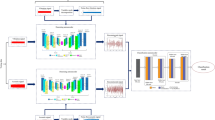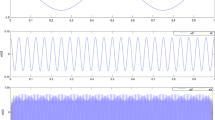Abstract
Based on the vibration spectrum analysis, this paper proposed a CMAC (Cerebellar Model Articulation Controller) neural network diagnosis technique to diagnose the fault type of turbine-generator sets. This novel fault diagnosis methodology contains an input layer, quantization layer, binary coding layer, excited memory addresses coding unit, and an output layer to indicate the fault type possibility. Firstly, we constructed the configuration of diagnosis scheme depending on the vibration fault patterns. Secondly, the known fault patterns were used to train the neural network. Finally, combined with a Visual C++ program the trained neural network can be used to diagnose the possible fault types of turbine-generator sets. Moreover, a PIC microcontroller based portable diagnosis apparatus is developed to implement the diagnosis scheme. All the diagnosis results demonstrate the following merits are obtained at least: 1) High learning and diagnosis speed. 2) High noise rejection ability. 3) Eliminate the weights interference between different fault type patterns. 4) Memory size is reduced by new excited addresses coding technique. 5) Implement easily by chip design technology.
Preview
Unable to display preview. Download preview PDF.
Similar content being viewed by others
References
Li, H., Sun, C.X., Hu, X.S., Yue, G., Wang, K.: The Fuzzy Inputting and Outputting Method in Vibration Fault Diagnosis of Steam Turbine-generator Set. Journal of Chongqing University (China) 22(6), 36–40 (1999)
Zhang, G., Yasuoka, K., Ishii, S.: Application of Fuzzy Equivalent Matrix for Fault Diagnosis of Oil-immersed Insulation. In: Proceeding of the 13th International Conference on Dielectric Liquids (ICDL 1999), pp. 400–403 (1999)
Su, Q., Mi, C., Lai, L.L., Austin, P.: A Fuzzy Dissolved Gas Analysis Method for the Diagnosis of Multiple Incipient Faults in a Transformer. IEEE Trans. on Power Systems 15(2), 593–598 (2000)
Dukarm, J.J.: Transformer Oil Diagnosis Using Fuzzy Logic and Neural Networks. In: Canadian Conference on Electrical and Computer Engineering, pp. 329–332 (1993)
Yang, H.T., Liao, C.C., Chou, J.H.: Fuzzy Learning Vector Quantization Networks for Power Transformer Condition Assessment. IEEE Trans. Dielectr. Insulation 8(1) (2001)
Wang, Z., Liu, Y., Griffin, P.J.: A Combined ANN and Expert System Tool for Transformer Fault Diagnosis. IEEE Trans. on PWRD 13(4), 1224–1229 (1998)
Lin, C.E., Ling, J.M., Huang, C.L.: An Expert System for Transformer Fault Diagnosis Using Dissolved Gas Analysis. IEEE Trans. on PWRD 8(1), 231–238 (1993)
Zhang, Y., Ding, X., Liu, Y., Griffin, P.J.: An Artificial Neural Network Approach to Transformer Fault Diagnosis. IEEE Trans. on PWRD 11(4), 1836–1841 (1996)
Yanming, T., Zheng, Q.: DGA Based Insulation Diagnosis of Power Transformer via ANN. In: Proceeding of the sixth Conference on Properties and Applications of Dielectric Materials, pp. 133–136 (1999)
Thang, K.F., Aggarwal, R.K., Esp, D.G., McGrail, A.J.: Statical and Neural Network Analysis of Dissolved in Power Transformers. In: IEE Dielectric Materials, Measurements and Applications Conference Publication, 473 (2000)
Yang, H.T., Chang, W.T., Huang, C.L.: A New Neural Networks Approach to on-line Fault Section Estimation Using Information of Protective Relays and Circuit Breakers. IEEE Trans. on PWRD 9(1), 220–229 (1994)
Wang, M.H., Chao, K.H., Hung, F.C.: The Fault Diagnosis of Power Station Using Neural Network. In: Proceeding of 86 Conference of Technology School on Designated Topic, Taiwan, pp. 102–111 (1997)
Mitchell, J.S.: Machinery Analysis and Monitoring. Pennwell Publishing Company (1981)
Umemara, S.: A New Health Monitoring System for Rotating Machinery. Mitsubishi Juke Giho 18(6), 71–78 (1981)
Li, H., Sun, C.X., Liao, R.J., Chen, W.G., Hu, X.S.: Improved BP Algorithm in Vibration Failure Diagnosis of Steam Turbine-generator Set. Journal of Chongqing University (China) 22(5), 47–52 (1999)
Li, H., Sun, C.X., Hu, X.S., Yue, G., Tang, N.F., Wang, K.: Study of Method on Adaptive Wavelets for Vibration Fault Diagnosis of Steam Turbine-generator Set. Journal of Electrical Engineering (China) 15(3), 57–60 (2000)
Szu, H., Brian, T.: Neural network adaptive wavelets for signal representation and classification. Optical Engineering 31(9), 1907–1916 (1992)
Brian, T., Szu, H.: Adaptive Wavelets Classification of Acoustic Backscatter and Imagery. Optical Engineering 30(7), 2192–2202 (1994)
Hung, C.P., Wang, M.H., Cheng, C.H., Lin, W.L.: Fault Diagnosis of Steam Turbinegenerator Using CMAC Neural Network Approach. In: Proceeding of International Joint Conference on Neural Network Publication, vol. 334 (2003)
Albus, J.S.: A New Approach to Manipulator Control: the Cerebeller Model Articulation Controller (CMAC)1. Trans. ASME J. Dynam., Syst. Meas. and Contr. 97, 220–227 (1975)
Hung, C.P., Wang, M.H.: Fault Diagnosis of Air-conditioning System Using CMAC Neural Network Approach. In: Advances in Soft Computing—Engineering, Design and Manufacturing, pp. 1–11. Springer, Heidelberg (2003)
Hung, C.P., Wang, M.H.: Diagnosis of Incipient Faults in Power Transfers Using CMAC Neural Network Approach. Electric Power Systems Research 71, 235–244 (2004)
Zhu, J.N., Miao, S.E., Wang, C.Q.: Implementation of Long-distance Vibration Monitor and Fault Diagnosis System for High Output Turbo-generator Units. Turbine Technology (China) 45(1), 5–7 (2003)
Chen, C.: The Study and Application of Turbo-generator Vibration Fault Diagnosis Based on Multi-symptom Input Neural Network Method. Master dissertation of Zhejiang University (2006)
Handeiman, D.A., Lane, S.H., Gelfand, J.J.: Integrating Neural Networks and Knowledge-based Systems for Intelligent Robotic Control. IEEE Control Syst. Mag., 77–86 (1990)
Wong, Y.F., Sideris, A.: Learning Convergence in the Cerebellar Model Articulation Controller. IEEE Trans. on Neural Network 3(1), 115–121 (1992)
Author information
Authors and Affiliations
Editor information
Editors and Affiliations
Rights and permissions
Copyright information
© 2009 Springer-Verlag Berlin Heidelberg
About this paper
Cite this paper
Hung, CP., Liu, WG., Su, HZ. (2009). Fault Diagnosis of Steam Turbine-Generator Sets Using CMAC Neural Network Approach and Portable Diagnosis Apparatus Implementation. In: Huang, DS., Jo, KH., Lee, HH., Kang, HJ., Bevilacqua, V. (eds) Emerging Intelligent Computing Technology and Applications. ICIC 2009. Lecture Notes in Computer Science, vol 5754. Springer, Berlin, Heidelberg. https://doi.org/10.1007/978-3-642-04070-2_78
Download citation
DOI: https://doi.org/10.1007/978-3-642-04070-2_78
Publisher Name: Springer, Berlin, Heidelberg
Print ISBN: 978-3-642-04069-6
Online ISBN: 978-3-642-04070-2
eBook Packages: Computer ScienceComputer Science (R0)




